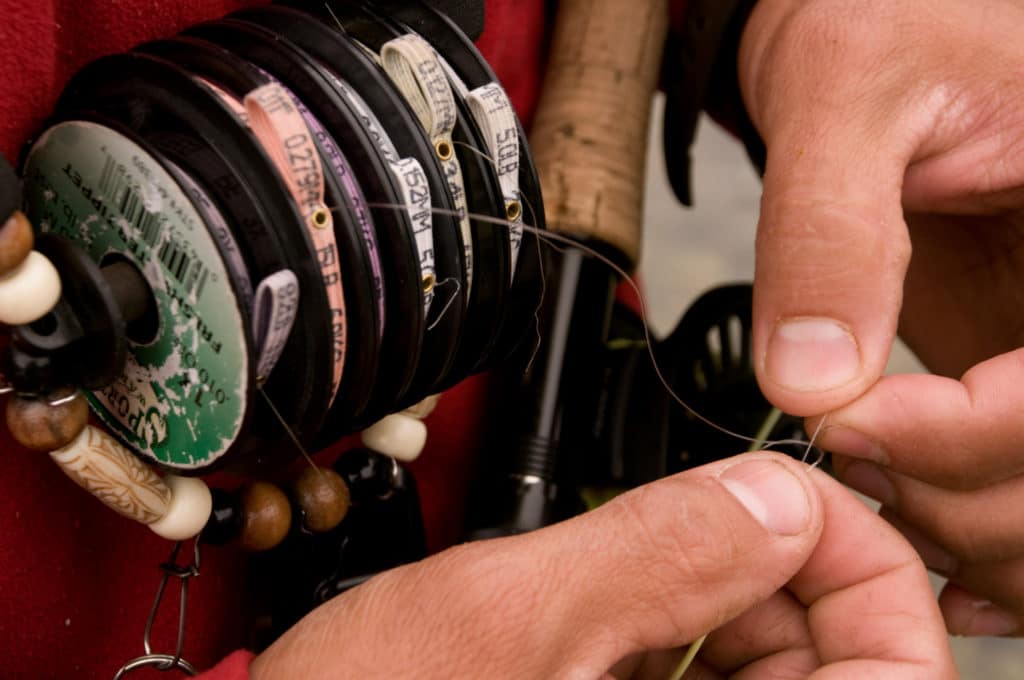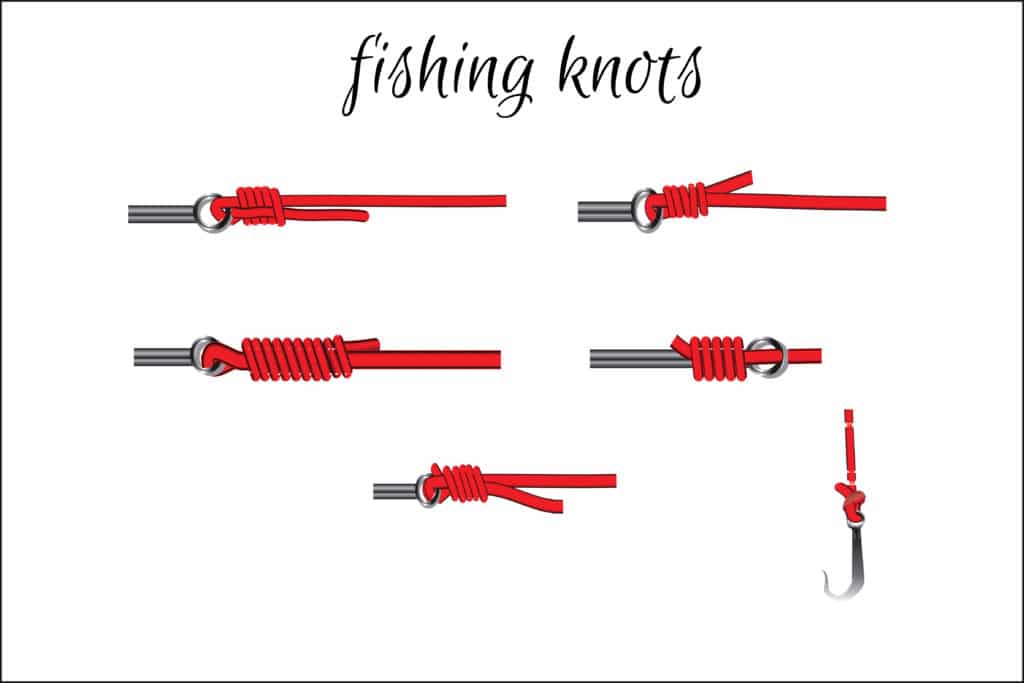The field of fishing knots is quite vast, but you should never ignore the uni fishing knot.
Any angler knows the effectiveness of this knot, considering the various applications you can use it for.
For instance, you can use the knot to tie directly to your hooks and lures, known as the classic uni knot, and make a double uni knot.
Here you join two lines together.
If you’re working on various lines and sizes, you can proceed to use your uni knot, which is why anglers believe that it’s the most useful knot.
Perfecting on making the knot may help you handle practically all knot situations that may arise when fishing.
And to excite you further is its simplicity to tie and the fact that it doesn’t break easily.

Contents
What is a Uni Fishing Knot?
A uni knot is also referred to as the Duncan Loop Knot or the Grinner Knot.
It’s one of the most effective and sustainable knots for connecting a monofilament leader to terminal tackles.
Numerous fishers choose it over the 5-turn improved clinch knot and a 6-turn clinch knot because it’s reliable and simpler to fix.

Pros Of The Uni Knot
- It’s a quick and simple knot to create with tiny tippets & small flies, especially in low-light settings.
- You can highly depend on the knot’s strength as it has a rating of 90%. So the chances of it failing is minimal compared to the enhanced clinch knot, which may mess you up if tightened wrongly.
- To tie the uni knot, you need a few spinnerbaits. This prolongs the durability of your leaders, reduces tippet consumption, and saves you money over time.
- It makes it easier to untangle knots in the water, saving you time.
- You can use the knot on practically any type and size of the line.
Cons Of The Uni Knot
- The knot is more substantial than other alternatives like the Palomar, Davy knots, or Orvis.
- It’s not as powerful as the Palomar Knot.
Steps To Connect The Lure Uni Knot/Line-To-Hook
- Slip the line through the lure eye/ hook.
- Place 6-inch long tag ends over through the mainline and pinch lines just above the hook eye.
- Twist the tag end around to make a ring at the front of the doubled lines, with the tag ends pointed upward.
- Thread the tag end around doubled lines in every loop round.
- Pull on the tag till your finger is firm, then pull on the mainline till the tie drops down against the lure/hook to lock it in place.
- Pull until the knot forms precisely above the hook.
Double Uni Knot/Line-To-Line
The line-to-line knot is famous and essential for saltwater anglers who use it to bind the fishing leader towards the mainline.
The link is significant because fishers often use the smallest line possible on their reel to optimize casting performance yet utilize a stronger leader to withstand the sharp teeth of the fish they are hunting.
The ultimate strength of the leader is often double that of the mainline; the line-to-line knot will become the weakest link in the system.
And the double uni knot is efficient and one of the most common line-to-line fishing knots.
When to Use the Double Uni Knot
With the various knots available n the market, mastering how to tie knots such as the double uni knot could be valuable for linking fluorocarbon leader or monofilament fishing line to braided line.
In addition, you can use your double uni knot when fly fishing, attaching braid to mono, and lure casting.
The good thing is that your two fishing lines do not have to be of similar diameter, but consider that the linkage would be stronger if they are not significantly varied in diameter.
However, some alternative fishing knots and hooks are ideal for joining lines of drastically differing diameters.
The strength of a double uni knot has been evaluated and given a good rate of at least 90%, making it an excellent knot among ocean fishers who frequently seek fast-moving game fish species.
Pros
- It has a strong breaking strength and it’s a quick tie.
- You can use it to connect nearly any kind and size of fishing line.
Cons
- Bulkier than other knot options
How to make a Double Unit Knot
Below are easy ways you can apply to tie a clinch knot:
- First, hold the midway of the overlapping lines using your left hand.
- In mono, make a loop with the tag end pointing up. Wrap the lead tag around the loop’s doubled line at the top (5 times for mono)
- To tighten the knot, pull on the main and tag leader lines. Then with your right hand, create a loop identical to the above step.
- Wrap the braid tag (10 times for braid or 5 times for fluorocarbon knots) around the doubled area at the top of the ring.
- Tighten the braid by pulling on the tag end coils with a single knot. When the knots are slipped into each other, they tighten and hold into position, establishing a solid link.
- Remove the tags and you’ll have a strong line-to-line link.
Types of Fishing Knots
Now that you understand the effectiveness of uni knots and how to tie a tight knot, let’s look at some of the strongest fishing knots outside the uni knot.
Albright knot: The Albright is a popular knot for connecting two line pieces, e.g., braided to wire or monofilament to braided. The Albright knot is simple to tie and handy for linking monofilaments of varying sizes. Albright performs best when you join a narrower line to a wider one to make biting easier. But a poorly tightened Albright will fail instantly, so you need to ensure you create the coils tight from the start.
Blood Knot: The Blood knot is an old reliable fishing knot famous among fly fishers for connecting two lines. But you need to tie 5 to 7 coils on each side of the loop to increase its strength. As a result, the knot is most effective with lines of roughly equal diameter.
Splicing knots: This is a permanent knot created by weaving the strands of a monoline or two knots together, making them one of the strongest knots. They are stronger than other knots as they are meant to be permanent. Undoing and remaking splice knots takes significantly longer than making other fishing knots.
Nonslip loop knot: This one creates an extremely strong fixed loop at the end of your fishing line as the loop doesn’t quite grab the lure. And so it allows for a more flexible connection and a more natural motion. The more you tighten, the more it changes. Also, the line’s strength is determined by the number of turns you create.
The Arbor knot is one of the most versatile knots for fastening fly line backing, fluorocarbon, and monofilament line to a big arbor fishing gear. But if you are using a nonslip spool, an arbor knot is not suggested for braided lines. However, assuming you want to use a braided line for your baitcasting reel, you should tie the knot for monofilament to the reel spool with an arbor knot before attaching the braided line.
Why You Should Consider Using a Knot Tying Tool
Knot tying tools appear in a range of forms and sizes, and they are intended to assist you in easily and accurately making popular fishing knots.
Some of these tools are created specifically for tying a knot, while others are multi-purpose.
The advantages of these tools include:
- They are easy on your hands.
- They help to create sold knots that don’t travel.
- They make the tying faster compared to working without one.
- They are lightweight and portable and work with all sorts of fishing lines.
Conclusion
The uni knot is a traditional and versatile fishing knot. It’s easy to make, provides a robust connection for fishing lines, and may be used for line-to-line and line-to-hook attachments.
Creating strong fishing knots is essential as loose knots may release your catch and mess up your whole fishing experience.
Learning to tie some of the most common knots, such as the Snell knot, Palamar knot, and other lure knots is an important aspect of learning how to fish.
So knowing how to tie this dependable fishing knot is essential if you enjoy fishing and want to thrive at it.







